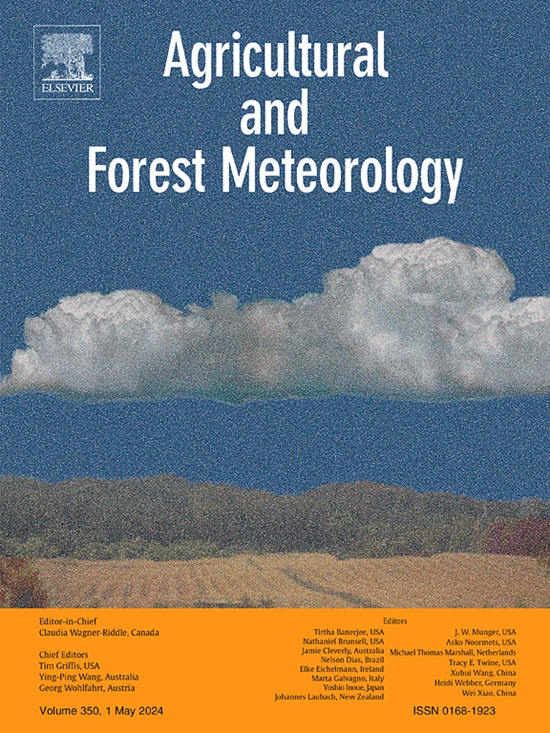Hydrothermal drivers of seasonal and interannual dynamics of soil respiration and its temperature sensitivity in a temperate semiarid shrubland
IF 5.6
1区 农林科学
Q1 AGRONOMY
引用次数: 0
Abstract
Despite the importance of soil respiration (Rs) in the global carbon (C) cycle, our understanding of the dynamics of Rs and its temperature sensitivity (Q10) over time and across timescales remains to be improved for dryland ecosystems. We measured Rs continuously in a temperate semiarid shrubland in northern China during 2013–2019 to examine seasonal and interannual variations in Rs and Q10. Daily mean Rs ranged from values close to zero in winter to 1–3 µmol CO2 m−2 s−1 in summer. Daily mean Rs increased exponentially with soil temperature (Ts) at 10-cm depth in spring and autumn, being greater in autumn at a given Ts, but decoupled from Ts in summer. Summertime Rs increased with soil water content (SWC) at 10-cm depth up to about 0.16 m3 m−3, beyond which it levelled off or decreased. Annual Rs ranged from 231.8 to 334.9 g C m−2 yr−1 and increased with summer rainfall amount. Estimates of Q10 were generally lower in spring than in autumn, and this difference was more obvious for seasonal Q10 (estimated from seasonal Rs−Ts relationships) than for diel Q10 (estimated from diel Rs−Ts relationships over a five-day moving window). Synchronizing the diel oscillations in Rs and Ts enhanced diel Q10 from 1.8 ± 0.4 (mean ± SD) to 2.5 ± 0.6, suggesting the need to consider the diel hysteresis between Rs and Ts for accurate modeling of hourly Rs dynamics. Both seasonal and diel Q10 decreased with increasing Ts, and diel Q10 increased with increasing SWC. Our findings demonstrate that hydrothermal controls on Rs and Q10 vary across seasons and timescales, and highlight the role of seasonal hydrothermal drivers in regulating long-term ecosystem C balance.
温带半干旱灌丛地土壤呼吸季节和年际动态的热液驱动因素及其温度敏感性
尽管土壤呼吸(Rs)在全球碳(C)循环中的重要性,但我们对旱地生态系统Rs及其温度敏感性(Q10)随时间和时间尺度的动态的理解仍有待改进。2013-2019年,我们在中国北方温带半干旱灌木林地连续测量Rs,以研究Rs和Q10的季节和年际变化。日平均Rs的范围从冬季接近于零到夏季1 - 3µmol CO2 m−2 s−1。日平均Rs在春、秋季随土壤温度(Ts)呈指数增长,在一定的Ts下,秋季较大,但在夏季与Ts脱钩。夏季土壤水分随土壤含水量(SWC)的增加而增加,最高可达0.16 m3 m−3,超过SWC则趋于平稳或下降。年Rs值为231.8 ~ 334.9 g C m−2 yr−1,随夏季降雨量增加而增加。Q10的估计值通常在春季低于秋季,季节性Q10(根据季节性Rs - Ts关系估计)的差异比日粮Q10(根据5天移动窗口内的日粮Rs - Ts关系估计)的差异更明显。同步Rs和Ts的diel振荡使diel Q10从1.8±0.4 (mean±SD)提高到2.5±0.6,表明需要考虑Rs和Ts之间的diel滞后性以准确建模逐时Rs动力学。季节Q10和日粮Q10均随Ts的增加而降低,日粮Q10随SWC的增加而升高。研究结果表明,热液对Rs和Q10的控制在不同季节和时间尺度上存在差异,并突出了季节性热液驱动因素在调节长期生态系统C平衡中的作用。
本文章由计算机程序翻译,如有差异,请以英文原文为准。
求助全文
约1分钟内获得全文
求助全文
来源期刊
CiteScore
10.30
自引率
9.70%
发文量
415
审稿时长
69 days
期刊介绍:
Agricultural and Forest Meteorology is an international journal for the publication of original articles and reviews on the inter-relationship between meteorology, agriculture, forestry, and natural ecosystems. Emphasis is on basic and applied scientific research relevant to practical problems in the field of plant and soil sciences, ecology and biogeochemistry as affected by weather as well as climate variability and change. Theoretical models should be tested against experimental data. Articles must appeal to an international audience. Special issues devoted to single topics are also published.
Typical topics include canopy micrometeorology (e.g. canopy radiation transfer, turbulence near the ground, evapotranspiration, energy balance, fluxes of trace gases), micrometeorological instrumentation (e.g., sensors for trace gases, flux measurement instruments, radiation measurement techniques), aerobiology (e.g. the dispersion of pollen, spores, insects and pesticides), biometeorology (e.g. the effect of weather and climate on plant distribution, crop yield, water-use efficiency, and plant phenology), forest-fire/weather interactions, and feedbacks from vegetation to weather and the climate system.

 求助内容:
求助内容: 应助结果提醒方式:
应助结果提醒方式:


